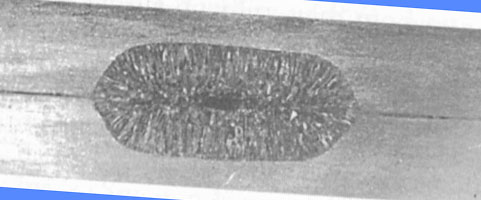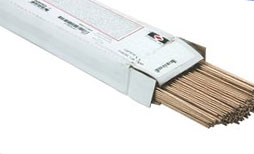Summary:
White metal is divided into three general classes according to the basic composition, i.e., zinc, aluminum, and magnesium. Most of the castings made are of the zinc alloy type. This alloy has a melting point of 725ºF (385ºC).

Zinc Alloys
Zinc alloys are slightly lighter than iron. There are two types used in welding:
- rolled zinc
- cast zinc
Common uses include cast forms such as die-casting, sheets used as roofing and in plants that do chemical processing.
The metal is brittle at room temperatures, requiring elevated temperatures for mechanical working. Sheet surfaces are often mechanically abraded for cleaning before spot welding begins.
Zinc alloys have 2x the electrical conductivity of steel, lower melting ranges, higher thermal conductivity and approximately the same specific heats.

Flame Adjustment
The welding flame should be adjusted to carburizing but no soot should be deposited on the joint. The oxyacetylene flame is much hotter than necessary and it is important to select a very small tip.

Welding Rod
The welding rod may be of pure zinc or a die-casting alloy of the same type as that to be welded. Metal flux (50 percent zinc chloride and 50 percent ammonium chloride) can be used, but is not mandatory.
Welding Technique
The castings should be heated until the metal begins to flow. Then turn the flame parallel to the surface, allowing the side of the flame to keep the metal soft while heating the welding rod to the same temperature. With both the base metal and the welding rod at the same temperature, the rod should be applied to and thoroughly fused with the walls of the joint. The rod should be manipulated so as to break up surface oxides.
Resistance Welding of Rolled Zinc Alloys
Resistance welding is a process used to weld rolled alloys. It uses the least heat input as compared to arc or gas welding and provides sound welds.
Seam or spot welding is done on flange or lap joints. The overlap size is dictated by the thickness of the metal sheet.
Welding areas should be cleaned and abraded using one of the following methods:
- sandpaper
- emery board
- buffing
- machining
- grinding
If needed also degrease the work area.
Resistance Welding Application
Resistance weld solid zinc strips with currents that are equivalent to low electrode forces and steel.
Due to metal softness and in general, greater thickness, zinc allow requires a low inertia follow-up for control of the welding electrode. Cavities or internal defects are commonly seen, but can be reduced with the utilization of a forging force.
When welding cast zinc alloys, use the same parameters established for rolled alloys. Since castings often have extra coatings, it is a best practice to remove them before welding.